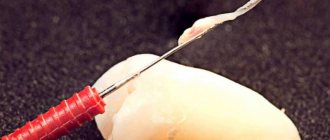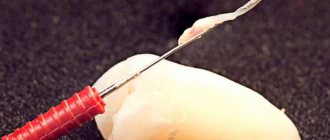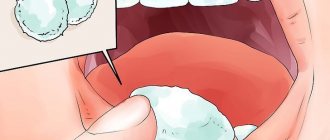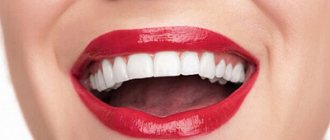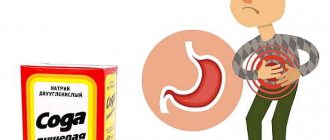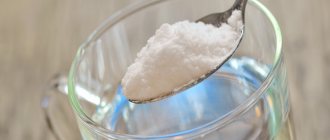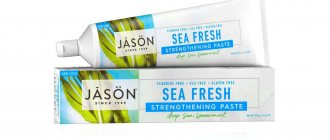Depulpation is a complex dental procedure that is not always successfully performed even in a clinic, not to mention nerve removal at home. The procedure is used in rare cases, for example, in cases of deep damage to dentin by carious processes or inflammation of the soft tissues of the tooth. The nerve endings are located in the pulp, which has a fibrous, loose structure. It is in this area that there is a nerve and a network of intertwined blood vessels through which nutrition is carried out.
After removal of the nerve, the tooth becomes more vulnerable to infectious pathogens. Gradually it darkens and loses its original strength characteristics. For this reason, before proceeding with depulpation, you need to make sure that this procedure is really necessary.
Indications for the procedure
Let's consider the main list of indications for the operation:
- Deep caries. Dentists advise patients to visit the clinic at least once every 6 months in order to identify and treat caries in the early stages of development. When only the enamel is affected, in 90% of cases it is possible to preserve the nerve endings of the tooth. The carious cavity can grow over several months and reach the dentin and pulp. In the latter case, a procedure to remove the nerve cannot be avoided.
- Unsuccessful dental treatment in the past. When removing tooth tissue damaged by caries, the doctor may accidentally open the pulp chamber. In this case, it will be important to remove the nerve to prevent the development of pulpitis under the filling. Amputation in this case can be complete or partial.
- The need for prosthetics. Typically, to restore the integrity of the row, prostheses are used that are attached to supporting units. The installation technology of most permanent structures involves depulping the elements that are considered as support. The procedure is necessarily carried out for teeth that are located at an angle.
- Serious mechanical damage to tooth tissue. Among the consequences of injuries are deep chips that affect the nerve endings of the teeth. In such cases, the damaged unit can rarely be saved, especially if we are talking about the front teeth. If the extreme molars are injured, then only partial depulpation is possible.
One of the main signs of incipient pulpitis is acute pain in the tooth of a vague nature. In rare cases, the disease becomes chronic and does not manifest itself with characteristic clinical signs. Only a dentist can accurately determine the presence of pulpitis using a thorough visual examination and temperature tests. If the doctor insists on depulpation, then you should not refuse the operation.
Symptoms of the lesion
The cause of the formation of a pathological process can be carious lesions, inflammation of soft tissues, or mechanical damage to the teeth. The main symptoms include severe aching pain that can radiate to the temporal tissue. You may experience bad breath. The painful area may react acutely to hot and cold foods. With the development of the pathological process, swelling, inflammation of the pulp chamber, and the formation of pus may be observed over the course of several days.
Many patients often wonder whether the nerve in a tooth can die on its own. Yes, maybe, if the destructive process has gone far enough. The main symptom will be a sudden cessation of pain. However, without timely dental intervention, the infection can spread further and affect the trigeminal nerve, leading to trigeminal neuralgia. The consequence will be impaired facial expressions, facial distortion and other anomalies.
Symptoms requiring nerve removal
At home, several tests will help determine whether the tooth nerve needs to be removed. The first symptom is prolonged toothache, which intensifies when eating or turning the head. The intensity of the symptom increases at night, when the person assumes a horizontal position. People with pulpitis find it difficult to sleep without painkillers.
At home, you can do a cold test to determine pulpitis. To do this, cool a cotton ball in the freezer and touch it to several teeth located in the painful area. Typically, the affected unit does not react to cold immediately, but over time.
Aching pain may also indicate the need to visit a doctor. In this case, unpleasant signs appear only under the influence of various irritants - heat, cold, acids. Discomfort persists for some time after eliminating the irritating factor.
What is strictly forbidden to do
There are also several strict restrictions and prohibitions that must be observed to avoid unwanted consequences. Here are the main ones:
- you can’t heat the causal area - no hot compresses, which only intensify the pain and provoke the spread of inflammation,
- you should not take a horizontal position - this will increase blood flow to the painful area, which will make the unpleasant sensations even more intense,
- Under no circumstances should you use needles - some try to pick out the cavity themselves, but this is strictly prohibited. Otherwise, you can provoke severe bleeding and even infection.
In no case should you attach a heating pad to an inflamed nerve.
Killing and removing a nerve from a tooth, even in dentistry, is considered a serious procedure that requires the proper experience and dexterity from a specialist. Therefore, in case of inflammation of the pulp, the help of a qualified specialist – an endodontist – is required. This is not a case where you can do it on your own. Don't risk your health.
1According to information at the office. manufacturer's website: vladmiva.ru.
Preparation before home depulpation
At home, you can kill the nerve of the tooth or reduce its sensitivity. In the first case, you will have to destroy the crown part of the tooth to get to the problem area.
Before suppressing the sensitivity of the structure, the following preparatory measures are performed:
- Decide whether it is necessary to kill the dental nerve or reduce its susceptibility to external irritants. The method of relief will depend on the intensity of the pain and the qualifications of the person who will carry out emergency measures.
- Treatment of the oral cavity with antiseptics.
- Cleaning the canals with a needle. It is preheated over a fire and treated with disinfectants, for example, Miramistin or Chlorophyllipt.
- Repeated antiseptic treatment of the mouth.
Toothache: causes
Under the dental crown in the canals there is a network of blood vessels and nerve fibers.
In this way, the tooth is connected with the rest of the body - its circulatory and nervous systems. The appearance of toothache indicates that the pathological process has reached the nerve, which signals a problem. As you know, pain is only a symptom, the causes of which still need to be known. Therefore, if the dental nerve hurts, then the right solution would be to go to the dentist. Often, when examined by a doctor, one of the following causes of toothache is determined:
- Caries . This is the most common reason for nerve pain. Pathogenic bacteria that inhabit the oral cavity produce lactic acid during their life, which corrodes the enamel. In the initial stages, caries does not cause pain. However, as the enamel is destroyed, the pathological process gets closer to the nerve. If pain occurs during caries, then this indicates an advanced process.
- Pulpitis . This is an inflammation of the internal tissues of the tooth. In fact, pulpitis is an advanced form of caries, when bacteria have eaten away the hard tissues of the tooth and reached the soft ones. The initial stages of pulpitis are characterized by acute pain, which may subside over time. The disappearance of pain indicates that the nerve is killed.
- Periodontitis . This is an inflammatory pathology of periodontal tissues. A characteristic symptom of periodontitis is bleeding gums and tooth mobility. Sometimes a person is bothered by pain. This problem requires treatment by a periodontist.
- Periostitis (flux) . This is a purulent lesion of the periosteum, often accompanied by severe throbbing pain.
- Dental hyperesthesia . This is increased tooth sensitivity that occurs when eating cold, hot or sour foods, as well as when inhaling cold air. There are several reasons for hyperesthesia. These are caries, increased wear of tooth enamel, as well as dental trauma and other reasons.
The dental nerve is also irritated under other diseases and circumstances, for example, with gingivitis, periodontitis, improper filling, and also after tooth extraction.
Why is nerve removal performed?
Long-term progressive pulpitis can ultimately lead to psychological disorders. This is due to the fact that a person constantly has to endure intense pain. Other complications of untimely intervention include:
- flux;
- osteomyelitis;
- periodontitis;
- dental granuloma;
- tooth loss.
Periodontitis is one of the dangerous complications of pulpitis
If the tooth has collapsed under the crown, the corrective device is removed and the element underneath is healed. The material of the prosthesis or crowns has better thermal conductivity than dentin and enamel. For this reason, severe cramps may occur when eating cold or hot food.
Causes of inflammation of the trigeminal nerve
Doctors believe that the main cause of inflammation of the trigeminal nerve is compression of it either inside the skull or outside it. Inside the skull, the trigeminal nerve can be compressed as a result of the formation of tumors, in most cases resulting from some kind of head injury.
Also a fairly common cause of inflammation of the trigeminal nerve is internal venous or arterial displacement.
Other causes of trigeminal neuralgia include:
- the presence of a chronic inflammatory process, viral or bacterial infection in the body;
- herpes infection (herpes);
- a brain tumor;
- scarring in the brain stem;
- failure of anesthesia during treatment or tooth extraction.
Most often, inflammation of the trigeminal nerve affects women at pre-retirement and retirement age (usually from fifty to seventy years). If trigeminal neuralgia is diagnosed in a young man or girl, then most likely its cause is a change in the arteries of a sclerotic nature or a strong dilatation of blood vessels.
Suppression of nervous sensitivity at home
In life, there are often situations when a tooth hurts, and it is not possible to see a doctor in the near future. Toothache is difficult to endure even with the help of powerful painkillers.
To reduce the intensity of signs of pulpitis, you can use proven folk remedies:
Tooth depulpation before prosthetics
- Comfrey tincture: 2 tsp. the plant component is poured with 50 ml of alcohol and left for 10 days. A cotton swab soaked in the solution is applied to the problem area.
- Soda solution. In 1 tbsp. l. boiled water stir 1 tsp. soda and 1 tsp. salt. Rinse your mouth with the product after each meal. Salt helps suppress the activity of pathogenic flora in the mouth, and soda reduces the severity of soft tissue swelling.
- Propolis-based tincture: 1 tbsp. l. crushed plant component is poured into 100 ml of 70% alcohol and left in a dark place for 10 days. Apply a cotton swab soaked in the product to the diseased tooth for 15 minutes.
- Hydrogen peroxide. The drug with a concentration of 3% is dissolved with water in a ratio of 2:1. The moistened cotton wool is applied to the problem tooth. The product can also be used as a mouth rinse.
- Onion peel, which has a powerful disinfecting effect: 3 tbsp. l. husks are poured with 500 ml of water and put on fire. After boiling, the drug is infused for 40 minutes and used to rinse the mouth 5-6 times a day.
- Herbal tincture. To create the medicine, take chamomile, thyme, lemon balm and mint. Herbs are taken in equal proportions and 500 ml of boiling water is poured. The decoction should be used warm (not hot). Otherwise, the severity of the inflammatory process near the problematic tooth may increase.
- Garlic. The vegetable is ground with salt and applied to the problem area for 15-20 minutes.
How does inflammation of the trigeminal nerve manifest?
The main symptom of inflammation of the trigeminal nerve is severe pain that occurs in the facial part. The pain really has a powerful force and shooting character, so it is very difficult for the patient to calmly endure painful attacks. The pain intensifies when performing the slightest actions with the facial muscles and jaws - yawning, chewing, laughing, and performing daily oral hygiene. At the same time, the sensitivity of the skin on the inflamed side of the face decreases.
The next painful attack is accompanied by a rapid dilation of the patient’s pupils and the same rapid contraction of facial muscles. Increased tear production may begin.
Pain with trigeminal neuralgia is severe, but not constant. The pain occurs for a few seconds and is interrupted for a while. But if the intervals between painful attacks are short, then it seems that the pain is constant. Trigeminal neuralgia is dangerous because the interval between attacks can be several weeks, and sometimes even several months. But after this period, the pain will certainly return. A long break does not mean that the disease has passed, so if you have already noticed symptoms of neuralgia once, you should immediately consult a doctor.
Removing dental nerves at home
Before you begin to destroy the nerve endings in the tooth, you should thoroughly clean the oral cavity of plaque and food debris. If this rule is ignored, suppuration may develop in the treated tooth.
Emergency measures carried out at home threaten human life, so they must be carried out with caution. How can you kill a nerve? Several methods of getting rid of pulp should be noted:
- Arsenic. The procedure uses pastes that contain arsenic compounds. It is prohibited to use the component in its pure form, as it is a potent poison and can cause poisoning. If more than 5 ml of arsenic is ingested, death occurs.
- Zinc. You can obtain the substance at home using newspapers. Zinc is found in printing ink. A newspaper with a large number of images is placed on a plate and set on fire. The resulting ash is collected with cotton wool and placed in a previously cleaned channel. The affected element is covered with another cotton swab.
- Vinegar essence. A small piece of cotton wool is dipped into vinegar with tweezers and applied to the sore tooth. It is very important that a piece of cotton wool does not come into contact with the mucous membranes of the mouth. Otherwise, soft tissue burns may occur.
If the preparatory measures and the nerve removal itself are carried out correctly, the pain will subside within a few hours. The danger of self-treatment lies in the fact that poorly treated canals can cause further spread of infection. You should visit a doctor in the coming days even if there is no pain in the tooth. It is not possible to drill out all the caries on your own.
To prevent tooth infection before visiting a doctor, you should regularly rinse your mouth with oak bark tincture and diluted aloe juice.
To disinfect the oral cavity after self-depulpation, you can use honey wax honeycombs. They are chewed after each meal.
What complications can there be from home methods?
Even a doctor during depulpation can make a mistake that will lead to undesirable consequences. What can we say about independent attempts to kill the pulp at home, without following any rules of asepsis and antiseptics. Among the possible negative consequences of such arrogance, experts note nerve separation, severe hemorrhage due to vascular injury, as well as the spread of inflammation to nearby tissues. Other possible problems include:
- allergic reaction to the substances used,
- injury to healthy tissues,
- burn of the mucous membrane,
- loss of taste sensitivity,
- infection and sepsis.
When using home methods, a burn may occur.
Most often, after trying to kill the pulp on their own using traditional methods, patients are faced with a severe burn of the mucous membrane. In other cases, the pulp is burned with preservation but serious damage to the nerve.
What to do after tooth depulpation
In the first few days, if pain occurs in pulpless teeth, you should use anti-inflammatory non-steroidal drugs:
- Ketanov. The effect of taking the drug is observed after 30 minutes, the effect of the medicine lasts for 5-6 hours. The product has many contraindications and side effects, so you should not get carried away with its use.
- Analgin. Can be used for toothache if it is not too intense. Relief from the condition after taking the medicine occurs quickly (within 15-20 minutes). Instead of Analgin, you can use Baralgin. It is able to relieve low-intensity aching pain in a tooth for a long time.
- Pentalgin. Used in cases where inflammatory complications after dental treatment are involved.
- Novalgin is an anesthetic with a pronounced anti-edematous effect. The effect of using the drug is observed within 15 minutes.
What is a nerve and what is it for?
Human teeth consist of an outer bony part (crown) and numerous blood vessels inside.
Blood and lymphatic vessels, small fibers and a whole network of nerve endings are located inside - in the pulp, which is inaccessible to the human eye. Nerve fibers go far into the roots along the canal. This is the natural anatomical structure of the human tooth.
At human birth, the nerve is a catalyst for the process of growth and proper nutrition of the tooth. Afterwards, the function changes - the endings are an indicator of the ongoing destruction of the outer crown.
Precautionary measures
To prevent folk remedies for toothache from harming your health, you should follow several basic rules:
- do not swallow mouthwash;
- avoid contact of antiseptic solutions with eyes;
- do not keep medications in your mouth for too long;
- follow the dosage of medications indicated in the instructions.
The effectiveness of home remedies for pulpitis is questionable, since a person himself will not be able to clean and fill the dental canals. Among the complications that arise during treatment at home, the following should be noted:
- burn of mucous structures;
- inflammation of the soft tissues of the mouth;
- poisoning.
In what cases is it necessary to kill him?
The dental nerve is killed in most cases for painless treatment. Moreover, deformation of the pulp - drilling the tooth to apply a filling - will subsequently provoke partial “exposure” of the nerve endings. As a result, even after treatment the person will experience pain.
Among all the reasons for killing the dental nerve are:
- prosthetics;
- deep carious cavity - when caries has affected the deep layers of the pulp;
- previous poor-quality dental treatment – pain occurred after dental intervention;
- mechanical injury.
Prerequisites also include inflammation of the pulp, developing periodontitis and other destructive processes of the dental crown.
Depulpation in a clinical setting
The procedure is most often painless, since before it the patient is injected into the gums with modern anesthetic drugs. It is possible to heal a diseased tooth in one visit to the dentist without using products containing arsenic.
Stages of the dental depulpation procedure:
- puncturing the gums located next to the diseased element with anesthetics;
- expansion of the channel 15 minutes after drug administration;
- treatment of the oral cavity with disinfectants;
- removal of the nerve using special dental equipment;
- repeated mouth antiseptics and filling of the root canal of the pulpless element.
If there are any problems with the operation, the dentist will heal the tooth according to a different scheme. After cleaning the canals, a medicine is placed into the carious cavity, which has an effect similar to arsenic, but is less dangerous for humans. After complete removal of the nerve endings, the doctor performs secondary cleaning of the canals. Permanent composite material is installed only after complete destruction of the nerve and cleansing of the canals from necrotic masses.
After the intervention, soreness of the unit and swelling of the soft tissues near it can be observed for 2-3 days. If the problem is accompanied by acute throbbing pain and fever, you should immediately consult a doctor again.
How to kill the pulp in dentistry
As for how to kill a nerve in dentistry, specialists for this purpose use two methods of depulpation - vital and devital. The first option involves amputation of the inflamed vascular bundle in one visit, under anesthesia. With the devitalizing method, the removal is carried out in two steps: at the first appointment, the doctor puts a devitalizing paste into the tooth and places a temporary filling on top, and at the second, he amputates the already dead pulp.
Quite aggressive arsenic compounds are used for killing. But today they are gradually being replaced by less toxic formaldehyde pastes. Below we will take a closer look at exactly what medications are used to kill the nerve.
Devitalizing pastes with arsenic: “Devit-Ars” and “Kaustinerv Rapid”
The basis of the drug "Devit-Ars" is arsenic anhydride. It leads to the gradual death of soft tissues and fairly rapid death of the pulp. To make this process painless for the patient, the composition also contains lidocaine.
The photo shows arsenic paste
It should be noted that the process of necrosis of living tissue requires strict control by a doctor, otherwise the consequences for the body can be very serious. It is very important to provide reliable protection against infection during this time. For this purpose, antiseptics are also added to the Devit-Ars paste - eugenol, chlorophenol and metacresol. As a rule, killing with this drug occurs literally within 24 hours1. In rare cases, the process takes a little longer, but usually no more than 2 days.
"Caustinerv Rapid" is another popular devitalizing drug in dentistry based on the same active substance. The composition also contains lidocaine, phenol, hydrochloric ephedrine and menthol. The devitalization process takes on average 2-3 days.
Arsenic-free pastes - formaldehyde
One of the most popular drugs in this category is Devit. It is based on paraformaldehyde, the action of which is aimed simultaneously at killing the pulp and antiseptic treatment of tissues. Lidocaine acts as an anesthetic component, and creosote is responsible for the antimicrobial properties.
Paste without the presence of arsenic can be used
To perform its immediate task, this formaldehyde paste requires much more time - up to 10 days. On the other hand, this is a much more gentle and safe method that poses virtually no threat to the body. Another important advantage of this type of devitalizing agents is the deep sterilization of the pulp chamber, which often makes it possible to preserve tissue at least partially.
Important! After arsenic paste, the doctor must carry out a very thorough treatment of the canals and make sure that there are no traces of a toxic substance there. When using formaldehyde compounds, this step can be skipped.
After 2 to 10 days, depending on the type of composition used, the patient needs to visit the doctor again to complete the treatment. He will remove the temporary filling, remove dead tissue, treat the canals and seal them. A permanent filling will be placed on top and sent for a control x-ray.
Answer-question section
Is it painful to perform depulpation?
In dentistry, powerful local anesthetics are used that completely block discomfort during the intervention. Severe pain may be felt if the drug is not suitable for the patient or was administered in the wrong dosage. Without pain relief, the process of treating a carious cavity is very painful.
Why do gums hurt after depulpation?
During the procedure, nerve endings are damaged. Because of this, pain persists for 2-3 days after the intervention. If the doctor performed all the manipulations correctly, the intensity of discomfort decreases, as a rule, by 2-3 days.
Is it possible to perform the procedure for free?
In public medical institutions, the procedure for removing the dental nerve is provided free of charge under the compulsory medical insurance policy. A separate additional payment for the administration of pain medication is possible.
Types of trigeminal neuralgia
Trigeminal neuralgia is divided into two types. The first, the so-called true trigeminal neuralgia, is a holistic disease caused in most cases by compression of the nerve or disruption of the blood supply. The second type - secondary trigeminal neuralgia - is a symptom of a general disease of the body. It could be a tumor or a serious infection.
In most cases, doctors diagnose inflammation of one of the processes of the trigeminal nerve, but in some situations inflammation of two or three processes occurs at once. Inflammation can affect either one side of the face or both, and in different combinations.
What should you not do if you have severe tooth pain?
We have already described several ways to kill the dental nerve at home, but there are procedures that should never be done, otherwise the consequences will be disastrous:
- Warming up. Hot compresses will only worsen the symptoms.
- Rest in a lying position. In the lying position, blood circulation is activated, and blood flows faster to the teeth. As a result, the pressure increases and the pain syndrome intensifies.
- Using a needle. Do not penetrate into the hollow of the tooth with a sharp needle, as this can damage soft tissues and cause bleeding.
All these methods lead to serious and irreversible consequences, which will then take a long time to eliminate in the dental office.
How to relieve pain with medications
If you do not want to deal with the above methods of tooth pain relief, you can use ready-made medications. All of them are intended only to eliminate pain; devitalization of the dental nerve does not occur in this case.
The most popular means include:
| Ketones | The most effective medicine for pain relief. Approved for use only by adults, it has a large number of contraindications. |
| Ketorol | An analogue of Ketanov with the same positive properties. It has many contraindications, which include diseases of the respiratory system, liver disorders, and stomach pathologies. |
| Took | Can relieve pain of moderate intensity. For people with increased hypersensitivity or during pregnancy, it is better not to take it. |
| Moment | Recommended for use to relieve inflammation and relieve pain. Dangerous for use during pregnancy and lactation; not recommended in the presence of ulcers or any pathologies of the circulatory system. |
| Solpadeine | Recommended for use when it is necessary to quickly relieve pain and inflammation. Do not use if you have problems with blood pressure. |
| It is based on valerian tincture and contains additional substances. Effective in the presence of mild pain. The drug is used to rinse a diseased tooth. | |
| Validol or Carvalol | They belong to the group of emergency drugs. A cotton ball is soaked in one of these products and applied to the diseased tooth. |
This is important: The products presented must be used in accordance with the instructions from the manufacturers. It is important to exclude the presence of contraindications.
How to kill with drugs
The use of the above products requires careful preparation, and then high-quality dental treatment.
The entire process of nerve removal includes the following steps:
- Opening the tooth - it is necessary to fully expose the pulp.
- Application of medication and temporary filling.
- Removing the applied composition, cleaning the canals, if necessary.
- Additional disinfection.
- Filling or other type of treatment.
- Control photo.
If you have severe pain, it is recommended to consult a dentist to identify the causes and develop appropriate treatment. Otherwise, you can only make the situation worse.
Cardinal methods
If rinsing and lotions do not help, then how can you kill the dental nerve at home? There are several drastic methods, but they can cause serious harm, so they are recommended to be used only in difficult cases and with extreme caution. Here are a few remedies:
- Vinegar essence. You need to moisten a cotton swab in it and place it carefully in the hollow of the tooth. But initially you need to thoroughly disinfect your hands to prevent infection. The procedure must be carried out carefully so as not to burn the gums.
- Alcohol. If rinsing with alcohol tinctures does not give any results, then you can moisten a cotton swab in medical alcohol and place it in the hollow of the tooth.
- Zinc. Not everyone has this substance in their home, but you can extract it yourself from printing ink. You need to take a sheet of newspaper with a large black design, crumple it up and set it on fire. Use a cotton swab moistened with human saliva to collect the ashes and place them in the tooth. This procedure is painful, so it is recommended to take a painkiller 20 minutes before the procedure.
Whatever method is used at home, you need to remember that this is a temporary measure; a visit to the dentist should still be necessary.
Why remove nerve endings?
Under the crown of the tooth there are nerve endings. They spread through the canals and reach the tooth roots. Nerves provide unity between the dental system and the central nervous system. They have their own sensory function. Pain in a tooth is a signal that indicates that the soft layers under the crown have undergone destruction.
As a result of depulpation (this is the removal of a bundle of nerves in the tooth canal), the pain goes away. After this procedure, the nutrition of the tooth ends. Subsequently, you will just need to monitor the crown and visit the dentist regularly. If you do not do this, the tooth will turn black and decay.
It is possible to save a nerve if a person asked for help in time, and did not look for an answer to the question of how to properly kill a dental nerve, and did not try a lot of different remedies on himself. Even if partial damage to the pulp has occurred, there is still a chance to neutralize the area without removing the pulp.
If you regularly visit a specialist, you may never encounter such problems.
